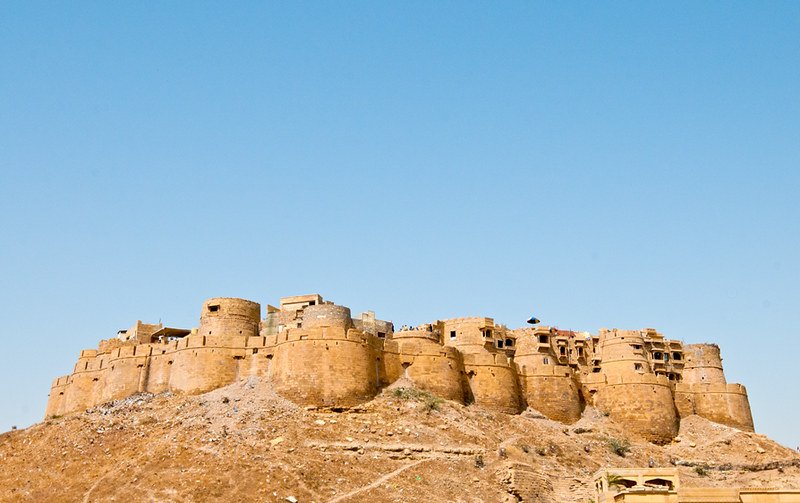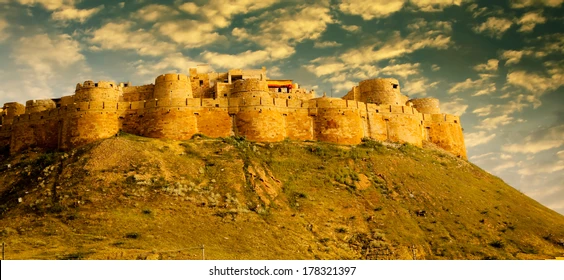Jaisalmer Fort majestically sits in the middle of the Thar Desert, outstandingly integrating into the historical and architectural feats of this building, which soars up to represent the royal heritage of Rajasthan. The fort stands tall, shining bright with its yellow sandstones acquiring for itself the sobriquet “Golden Fort.” This majestic edifice soars upwards, as if it were a mirage on the desert grounds. But what is so special about this fort? Living history combined with teeming community life makes it one of the few inhabited forts of the world. A Short History of Jaisalmer Fort The Jaisalmer Fort has overseen centuries against chronology in time. From its early beginning as a strategic military outpost, teeming trade centre along the silk route, the fort has seen it all. The undulating walls whisper stories about bravery, perfidy, and enduringwalts-a fascinating monument for the history buffs. The Architecture of Jaisalmer Fort Jaisalmer Fort is the greatest manifestation of Rajasthan craftsmanship, displaying immense carvings and strong fortifications. Unique Yellow Sandstone The fort is made with yellow sandstone and hence carries an aura of golden tinge, assuming a honey-gold color when the sun strikes it at sunrise and sunset. It has thus acquired the name “Sonar Quila,” which means “Golden Fort.” The Fort Structure and Layout The fort sprawls over a hill with a good well-planned layout-a complex network of narrow winding lanes, temples, palaces, and residential areas. Large walls with 99 bastions provide an imposing defense against invaders. Notable Gates and Entrances The four major entrances to the fort are the Akshya Pol, the Ganesh Pol, the Suraj Pol, and the Hawa Pol. Every gate is designed in such a strategic way that due to the sharp turns, any enemy forces find it difficult to penetrate the fort with much ease. These are examples of Rajasthani art with minute carvings and pointed metal spikes to prevent elephant attacks. Major Features of Jaisalmer Fort There is a number of important structures inside the fort of Jaisalmer; rich cultural and religious diversity of the region finds its representation. Raj Mahal: The Royal Palace Main buildings dominating inside the fort include Raj Mahal or Royal Palace, which has been in use by the kings of Jaisalmer since times immemorial. It depicts beautiful Rajput architecture with beautifully carved balconies, windows, and doors. Inside the precincts of the fort are seven Jain temples built between the 12th and 15th century. The temples in Chittorgarh Fort are extremely famous for the amount of carvings and minute details that their artistry does; narrating stories of Jain mythology. Laxminath Temple:

A Spiritual Hub The other major holy place of the fort is a temple called Laxminath, which was dedicated to the Hindu god Vishnu and goddess Lakshmi. This is a glorious example of ancient Indian temple architecture and shares pride among the most important in the heart of every citizen inhabiting the fort. Cultural Significance of Jaisalmer Fort Besides being a historical and architectural giant, Jaisalmer Fort has a very spirited culture. Festivals and Events at the Fort During the Desert Festival, skrilts of Rajasthani folk music and dance lighten up the three-day extravaganza with camel races among others. Visitors from everywhere come to witness such a kind of festival, where rich cultural heritage in this region is brought out into light. The Fort as a Living Monument Unlike so many historical sites, Jaisalmer Fort is alive; within its precincts a whole thriving community of people has lived for generations. This feature alone makes the fort very real and vibrant, places the past and the present together at ease with each other. The Strategic Importance of Jaisalmer Fort Everything had something to do with its strategic location and robust mechanisms of defense. Location and Historical Defense Mechanisms It is situated on the crown of Trikuta Hill; it commands an extensive view of the surrounding desert, hence making its location perfect for various advancements of enemies. Besides thick walls and an intricately designed layout to check the entries and exits of the enemy, there are other features developed with defense in mind thereby making it almost impregnable in times of yore. The Fort’s Role in Trade and Commerce Besides military importance, Jaisalmer Fort was also a vital center for trade and commerce. It lay on the ancient Silk Route joining India to Central Asia and Europe. Merchants of different regions coming this way would halt here to trade goods, further adding to the prosperity and the importance of the fort. The Legend of Rawal Jaisal Local folklore has it that the founder of the fort, Rawal Jaisal, was instructed by a local hermit by the name of Eesul to construct the fort on Trikuta Hill. The fort, according to the prophecy of the hermit, was supposed to be an unconquerable bastion-a fact that has been substantially true over all these centuries. Tales of Valor and Romance A number of tales of bravery, romance, and sacrifice have knotted the walls of this fort. Undoubtedly, most famous is the legend of Princess Tila who favored jumping into the flames rather than being taken by the invading forces. The heroic sacrifice has yet been remembered and respected by the people of Jaisalmer. Impact of Tourism on Jaisalmer Fort Tourism at Jaisalmer Fort-the opportunities and challenges seem many-dimensional. How Tourism Shapes the Fort Today Tourism is one of the major sources of income amongst its residents offering both employment as well as business opportunities.

Simultaneously, though flooding tourists strain the structure of the fort and need to be managed cautiously in order to preserve it. Preservation Efforts and Challenges In this fort, there are certain preservations for its continuity and for keeping its rich heritage alive. Many organizations along with other bodies of the government too make efforts to keep the structures of this fort intact and restored. Seepage of water, pollution, and over crowding is seriously threatening life of the fort. Best Time to Visit Jaisalmer Fort Planning a Tour to Jaisalmer Fort? Here’s all that you need to know about the best time to pay a visit to this place. Weather Considerations It is desirable to make a visit to Jaisalmer Fort when the climate is not at its extreme. The cooler months of October onwards and up to March are the ideal time. The climate during this time is soft and, therefore, is agreeable for tourists to view the fort and other areas surrounding it. The summer periods are quite extreme, as the temperature goes high above 40°C or 104° F, which is highly unfavorable for the tourists. Events and Festivals to Enjoy This is the most vibrant time to visit the fort. Usually in February, the Desert Festival, depicting traditional Rajasthani culture forms a great time to glimpse and enjoy the cultural performances and activities. Tourist Experience at Jaisalmer Fort Whatever one does-guided tour or on one’s own-Jaisalmer Fort has something different in store for its visitors. Guided Tours and What to Expect With this view, there are guided tours available that enable the visitor to take a closer look into the history and architecture of it. Such tours yield valuable information since the guides conducting them are well-read enough to bring alive the stories of the fort. Self-guided Touring of the Fort While the more adventurous may find a walk alone through the narrow lanes, temples, and among the fort’s resident population singularly rewarding ways of discovering life inside the fort. Local Cuisine and Shopping Around the Fort No tour to Jaisalmer Fort will be complete without tasting some local cuisine and going on a bit of souvenir shopping. Must-Try Dishes in Jaisalmer During a visit, most of the non-missable things include the local cuisine: Dal Baati Churma, Ker Sangri, and Gatte ki Sabzi are many such local delicacies full of flavor that assure one of getting the real taste of Rajasthani cuisine. Shopping for Souvenirs and Handicrafts Equally well known are the handicrafts of Jaisalmer, starting from embroidered garments to various forms of jewellery and leather articles. The bazaars surrounding the fort are ideal for selecting unique souvenirs to take back home. Jaisalmer Fort in Popular Culture Needless to say, Jaisalmer Fort has been captured in enough films and books. Movies and Books That Depict the Fort It has come into view, due to its magnificent architecture and natural drama, as a backdrop for the shooting of many Bollywood movies. Its place finds a mention among many books and travelogues, which makes its place stronger in the popular culture. Influence of the Fort on Art and Media The dynamic and vibrant colors of Jaisalmer Fort catch the attention of most artists and photographers. More than dozens of works are reproduced about this fort, and it is one of the most favorable subjects of artists and skilled craftsmen. Hotels near Jaisalmer Fort You will find a number of luxury and economy class hotels near Jaisalmer Fort. Hotel and Guesthouses in Vicinity If you intend to stay outside the fort, its surroundings have adequate hotels and guest houses, catering to all kinds of pockets. Most of them offer great views of the fort with easy approach to the main attractions. Tips to Visit Jaisalmer Fort A few of these tips would come in handy if you intend to make optimum use of time spent at this fort. What to Wear and Bring As the place falls in a desert area, so one should dress accordingly. Whenever visiting the fort, respect the culture and traditions of locals. Dress appropriately, and most importantly dress well at the temples. Give respect to the inhabitants who dwell inside the fort. If you wish to click pictures of people always seek permission. Conservation Efforts and Future of Jaisalmer Fort There are quite a number of organisations that find it of great significance to conserve the Jaisalmer Fort for times to come. Current Preservation Projects There exist various preservation projects that help in restoring the fort structures. The projects also assist in saving the fort from environmental destruction and help retain the historic entity. Contemporary Issues of the Fort That said, Jaisalmer Fort does have to confront a number of issues in this day and age. The most significant ones are water seepage through its body and erosion of the ground that it stands on. It also has to deal with increased pressures brought on by tourism. Conclusion Whether it’s magnificent architecture, teeming life of the vibrant community inside, or even exciting history and legends behind it, this fort gives a peep into a very unique past. Be it history, culture, or just the experience that one seeks, come get your fill in Jaisalmer Fort.




